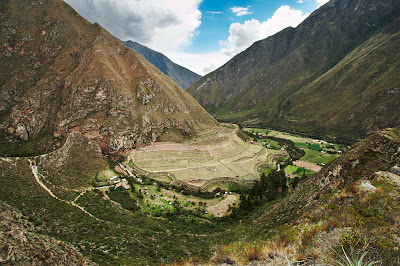 Us and La Paz
Us and La Paz
There is a stretch of dirt cut into the mountains between La Paz and Coroico that until recently held claim to the title of the World's Most Dangerous Road. Up to 300 people a year used to come to horrible ends on this road, hence the grizzly superlative. About a year ago a shiny new bitummen strip was installed on the opposite side of the valley, doing away with the need for vehicles to crawl around the slippery, guardrail-less curves perched atop hundreds of metres of rainforesty freefall. These days the Death Road is the almost exclusive domain of Gringo mountain bikers out for a day of supervised downhill death defiance.

Our party of four set out from La Paz and climbed in a van to the plus 4000 metre starting point. The road starts in the clouds and winds earthwards into a valley. The usual Bolivian roadside decorations of plastic bottles and nappies are replaced, almost in equal numbers, by crosses and memorials for those that didn't make it further. Skeletal wreckage of buses and other vehicles can be seen below this initial length of bitumen, and the cold wind stings your ears.

The scenery is bleak and massive; huge mountains covered in dark low vegetation are spoted with cloud. After a drug checkpoint or two, there is a chest-popping length of uphill (we are still above 3000 metres here), which Angie and Bre chose to negotiate in the support van (cheating).
 The Road
The Road
 This is us looking at the remains of a beer truck at the bottom of the valley
This is us looking at the remains of a beer truck at the bottom of the valleyThe real Death Road begins soon after. We left the bitumen, deflated our tyres and began the traverse down the loose gravel. By now we had left the lifelessness of the altiplano behind and were cautiously careening through the beginnings of the Amazonian jungle. Every now and then a single lane stretch of straight road would appear from the curves, and we could release the iron grips we held on the brake levers, but soon enough a bend would materialise and it was back to the overly cautious pace of a biking snail.


When not utilising every ounce of concentration on keeping from going over the edge, we were able to catch a look over the ever present edge and see the valley floor terrifying distances down. Our guide hurtled around the curves regardless, always keen to get ahead so he could snap photos of our steady descent.
 Resting on the memorial of one poor biker who didn't get to the bottom
Resting on the memorial of one poor biker who didn't get to the bottomAs the road continued our confidence grew, and Angie suprised everyone by having quite knack for steering a bike around the dirty, deadly curves. We rolled downward for about three hours, passing by waterfalls, rusting wreckage, memorials and slowpoke riders from other tour groups.

 You're supposed to lift your bike above your head here, but our jelly arms were barely capable
You're supposed to lift your bike above your head here, but our jelly arms were barely capableBy mid-afternoon we had finished and found ourselves lunching in a lush jungle resort, 3.5 kilometres below where we had started that morning. We could breathe again, and we had ridden the 'most dangerous stretch of road in the world'. High on achievement, adrenaline and air thick with oxygen we said bye to the guides and wobbled off to the next destination.

 These guys are absolutely incredible- human cargo trucks each carrying up to 30kg at a pace that puts daypack carting trekkers to shame. The most often heard word on the Trail is 'Porters!'. When that word is shouted from behind, you have about a second to get off the track and let the group of carriers fly past, carrying everything that is needed on a trip like this.
These guys are absolutely incredible- human cargo trucks each carrying up to 30kg at a pace that puts daypack carting trekkers to shame. The most often heard word on the Trail is 'Porters!'. When that word is shouted from behind, you have about a second to get off the track and let the group of carriers fly past, carrying everything that is needed on a trip like this.


















































